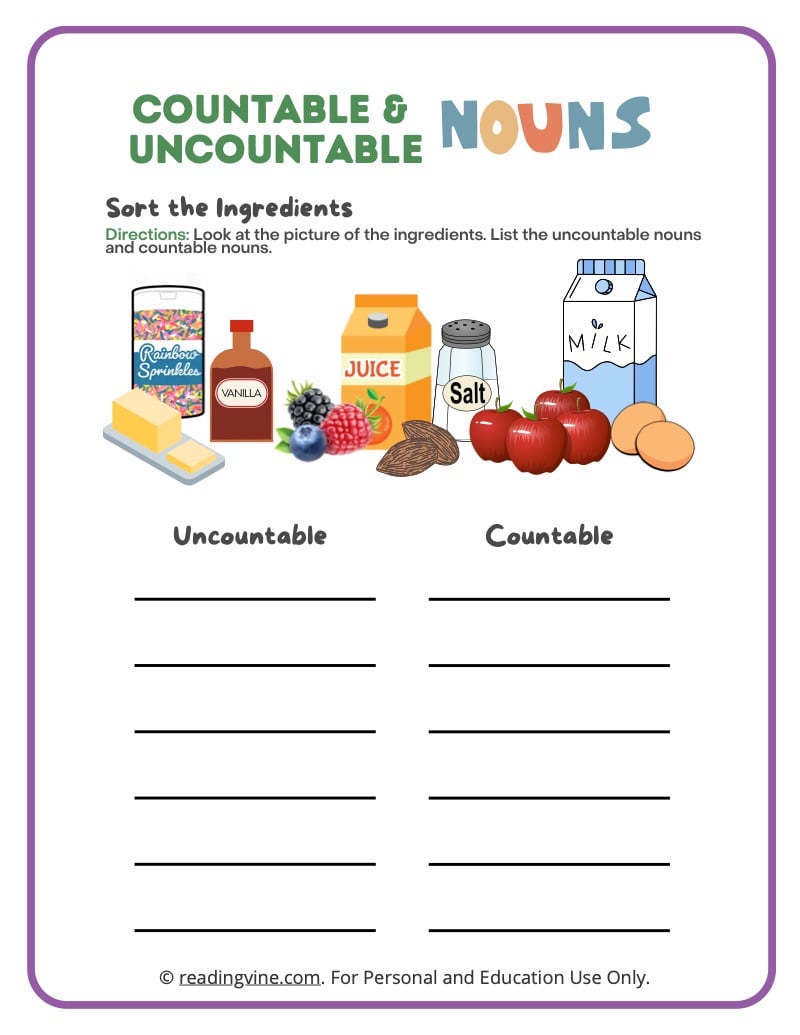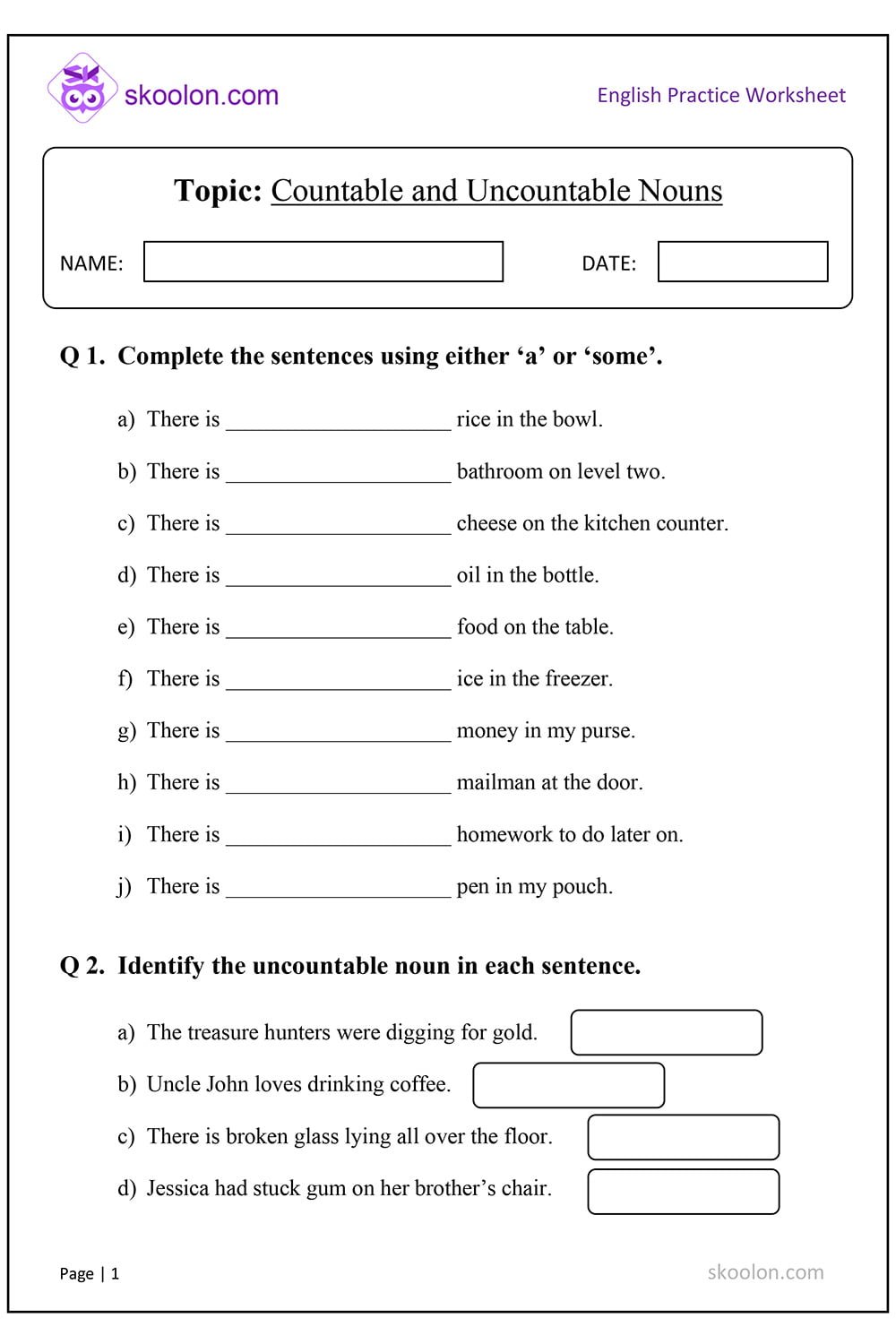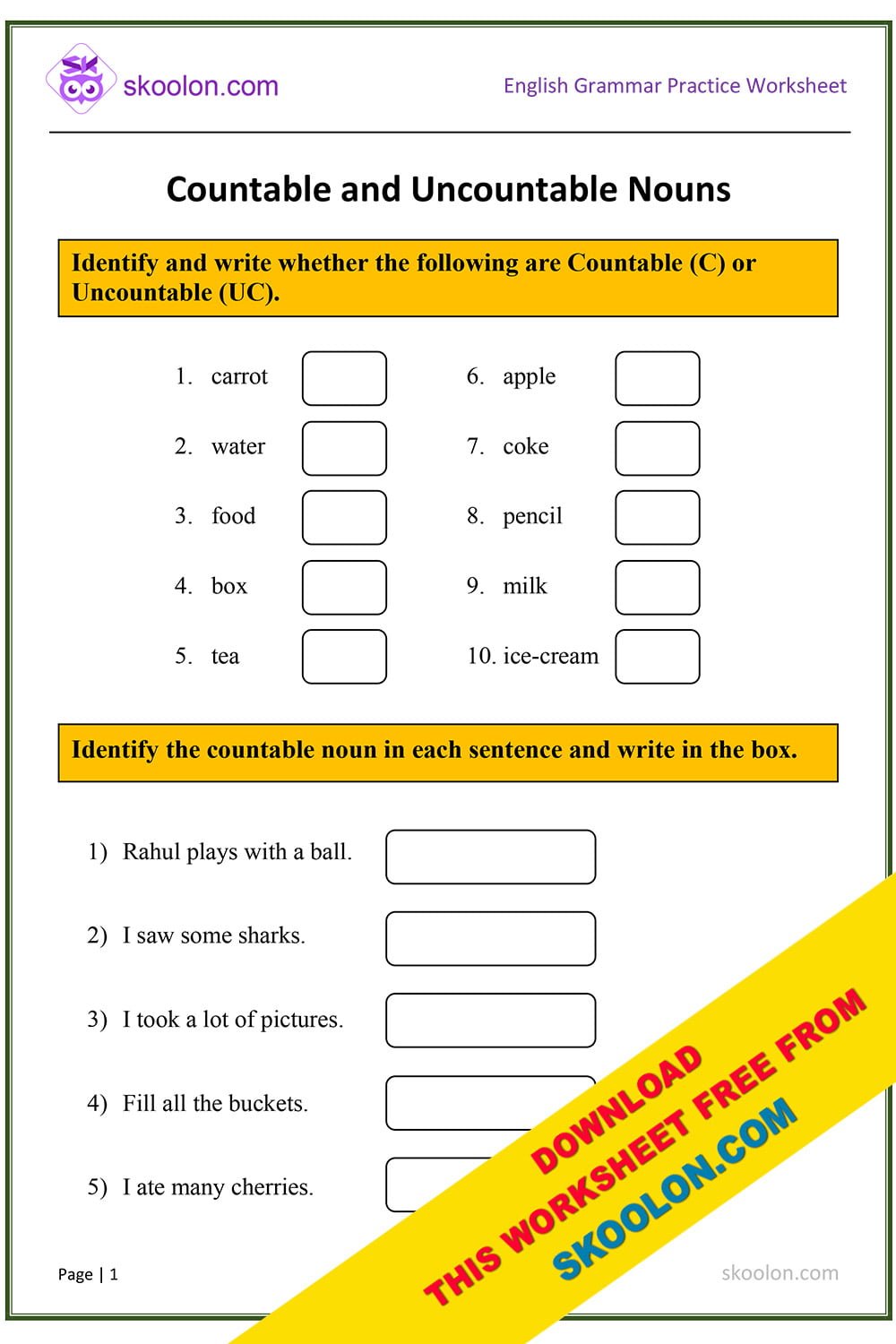
Mastering the Mundane: How Grammar Worksheets: Countables/Uncountables Pave the Way to Fluency
The English language, with its vast vocabulary and often idiosyncratic rules, presents a unique challenge to learners worldwide. Among the most persistent and subtle hurdles is the distinction between countable and uncountable nouns. While seemingly minor, a firm grasp of this grammatical concept is crucial for accurate expression, natural-sounding speech, and effective communication. This is where well-designed Grammar Worksheets: Countables/Uncountables emerge as an invaluable tool, providing structured practice that transforms confusion into clarity, ultimately paving the way for greater fluency.
The Nuance of Countables and Uncountables: Why It Matters
Countable nouns (e.g., "apple," "chair," "idea") refer to things that can be counted individually and have both singular and plural forms. Uncountable nouns (e.g., "water," "information," "advice") refer to things that cannot be counted individually and typically do not have a plural form. They often represent abstract concepts, substances, or collections.

The distinction goes far beyond mere classification; it dictates the use of articles (a/an/the), quantifiers (much/many, few/little, some/any), and even verb agreement. Consider the difference between "I have a few books" (meaning some, but not many, specific books) and "I have a little information" (meaning some, but not much, general information). Misusing these can lead to awkward sentences, misunderstandings, and a lack of precision that detracts from a speaker’s or writer’s credibility. For instance, saying "I have many advices" instead of "I have a lot of advice" immediately flags a learner’s struggle with this concept.

Furthermore, many languages do not make this same strict distinction, or they classify nouns differently. What is countable in one language might be uncountable in English, and vice-versa, creating a direct point of interference for learners. This inherent challenge underscores the need for dedicated, systematic practice – a need perfectly addressed by targeted Grammar Worksheets: Countables/Uncountables.

The Indispensable Role of Grammar Worksheets

Grammar worksheets, in general, serve as a foundational element in language acquisition. They offer a controlled environment where learners can focus on specific grammatical structures without the pressure of spontaneous conversation. They allow for repetition, which is key to internalizing rules, and provide immediate feedback, especially when paired with an answer key. This self-correction mechanism is vital for independent learning and building confidence.

When it comes to the specific complexities of countables and uncountables, these worksheets become even more critical. They break down the topic into manageable chunks, allowing learners to identify, categorize, and apply the rules systematically. Without such structured practice, learners often fall back on intuition or direct translation from their native language, leading to persistent errors.
The Specific Benefits of Grammar Worksheets: Countables/Uncountables
Grammar Worksheets: Countables/Uncountables offer a myriad of benefits tailored to this particular grammatical challenge:
- Targeted Practice: Unlike general grammar exercises, these worksheets zero in on the specific nuances of countable and uncountable nouns, ensuring focused attention on the core problem areas.
- Clear Categorization: Many exercises involve categorizing lists of nouns, helping learners to internalize which words belong to which group. This visual and active sorting process reinforces the distinction.
- Application of Quantifiers: Worksheets are ideal for practicing the correct usage of quantifiers (much/many, few/little, some/any, a lot of, etc.) which are inextricably linked to countable/uncountable nouns. Learners fill in blanks, choose the correct option, or transform sentences, solidifying their understanding through active application.
- Error Identification and Correction: Exercises that require learners to identify and correct errors in sentences containing misused countables/uncountables or their associated quantifiers are highly effective. This meta-linguistic skill encourages critical thinking about grammar.
- Contextualized Learning: The best worksheets present nouns within meaningful sentences or short paragraphs, demonstrating their use in natural contexts rather than as isolated words. This helps learners understand not just the rule, but also its practical application.
- Reinforcement and Repetition: Mastery of grammar comes through consistent practice. Worksheets provide ample opportunities for repetition, allowing the correct patterns to become automatic.
- Self-Paced Learning: Learners can work through the exercises at their own pace, reviewing sections as needed and spending more time on areas they find particularly challenging. This autonomy empowers learners and caters to diverse learning styles.
- Foundation for Advanced Concepts: A solid understanding of countables and uncountables is a prerequisite for more complex grammatical structures and idiomatic expressions. These worksheets build that essential foundation.




Types of Exercises Found in Effective Grammar Worksheets: Countables/Uncountables
To truly be effective, Grammar Worksheets: Countables/Uncountables should incorporate a variety of exercise types to engage different learning styles and address various aspects of the concept.
-
Identification and Categorization:
- Task: Given a list of nouns, learners classify them as "C" (countable) or "U" (uncountable).
- Example: Water (U), Book (C), Advice (U), Chair (C), Information (U), Apple (C).
- Benefit: Establishes the foundational recognition.
-
Quantifier Selection (Fill-in-the-Blanks):
- Task: Learners choose the correct quantifier (much/many, few/little, some/any, a lot of) to complete sentences.
- Example: There isn’t __ milk in the fridge. (much) / She has __ friends in the city. (many)
- Benefit: Directly applies the rule of quantifiers with C/U nouns.
-
Sentence Completion/Construction:
- Task: Learners complete sentences using appropriate countable or uncountable nouns, sometimes with a given quantifier.
- Example: I need to buy some __ for dinner. (food/vegetables) / Could you give me some __ about the project? (information/details)
- Benefit: Encourages active recall and creative application.
-
Error Correction:
- Task: Learners identify and correct grammatical errors related to countable/uncountable nouns and their quantifiers in sentences.
- Example: She gave me many advices. (Correction: a lot of advice) / I only have a little books. (Correction: a few books)
- Benefit: Develops critical analysis and reinforces correct usage.
-
Sentence Transformation:
- Task: Learners rewrite sentences, changing nouns from singular to plural (if countable), or rephrasing to accommodate uncountable nouns.
- Example: Change "I need an apple" to plural. (I need some apples.) / Rewrite "I have a lot of problems" using "few." (I have few problems.)
- Benefit: Encourages flexibility and deeper understanding of noun properties.
-
Contextual Passages/Reading Comprehension:
- Task: Learners read a short passage (e.g., a recipe, a news article, a dialogue) and identify all countable and uncountable nouns, or fill in missing quantifiers based on context.
- Benefit: Connects grammatical rules to real-world language use, enhancing comprehension.
-
Creative Writing Prompts:
- Task: Learners write short paragraphs or sentences based on prompts, specifically requiring the use of certain countable or uncountable nouns and quantifiers.
- Example: Describe your ideal breakfast, ensuring you use at least two countable and two uncountable nouns with appropriate quantifiers.
- Benefit: Promotes active production and integration of the learned concepts.
Designing and Utilizing Effective Worksheets
For Grammar Worksheets: Countables/Uncountables to be truly effective, their design and implementation are key:
- Clear Instructions: Ensure learners understand exactly what is expected of them for each exercise.
- Gradual Difficulty: Start with simpler identification tasks and progress to more complex application and error correction exercises.
- Contextual Relevance: Use examples that are relevant to learners’ lives and interests to make the practice more engaging.
- Visual Aids: Incorporate images, especially for beginners, to help distinguish between concrete countable items and abstract or mass uncountables.
- Answer Keys: Provide clear, concise answer keys for immediate feedback and self-correction.
- Varied Formats: Mix and match exercise types to keep learners engaged and address different aspects of the concept.
- Regular Review: Revisit the topic periodically with new worksheets to ensure retention and reinforce learning.
Worksheets can be used in various settings: as self-study material for independent learners, as homework assignments to reinforce classroom lessons, or as in-class activities to facilitate group discussion and peer learning. They can also serve as diagnostic tools to identify specific areas where learners struggle, allowing instructors to tailor future lessons.
Beyond the Worksheet: Integrating Practice into Fluency
While Grammar Worksheets: Countables/Uncountables are a powerful tool, they are a means to an end, not the end itself. The ultimate goal is to integrate this knowledge into natural, fluent communication. Once learners have a solid theoretical understanding and sufficient practice through worksheets, they must be encouraged to:
- Speak: Actively use countable and uncountable nouns with correct quantifiers in conversations, role-plays, and presentations.
- Listen: Pay attention to how native speakers use these nouns and quantifiers in various contexts (movies, podcasts, conversations).
- Read: Observe and analyze the usage of countable and uncountable nouns in authentic texts (books, articles, websites).
- Write: Apply the rules consistently in essays, emails, and creative writing.
The transition from controlled practice on worksheets to spontaneous production is crucial. Worksheets build the muscle memory; real-world application hones it.
Conclusion
The distinction between countable and uncountable nouns is a cornerstone of accurate English grammar, often presenting a significant challenge due to its subtle nature and differences from other languages. However, with the right tools, this challenge can be systematically overcome. Grammar Worksheets: Countables/Uncountables stand out as an exceptionally effective resource, offering focused, varied, and repetitive practice that solidifies understanding and builds confidence. By breaking down complex rules into manageable exercises, these worksheets empower learners to master one of English’s most pervasive grammatical hurdles, ultimately paving the way for clearer, more natural, and more fluent communication. Embracing these dedicated tools is not just about correcting errors; it’s about unlocking a deeper, more intuitive grasp of the English language.
